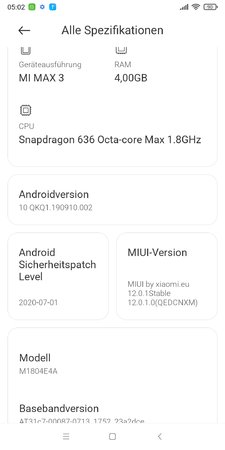L
linuxnutzer
Enthusiast
- 182
Mein Max3 war vor dem Unlock bzgl. Updates aktuell und sieht nun so aus:

Unlock ist bestätigt:

Ich frage mich, ob es da irgendwelche Fußangeln gibt:
MIUI 12.0 - MIUI 12.0 STABLE RELEASE
Was bedeutet das nun, dass ich System nicht löschen darf? Bei jeder neuen CustomROM-Installation muss ja ein System-Wipe durchgeführt werden. Kann ich zB nach einem AOSP-ROM das Xiaomi-EU-ROM nicht mehr flashen, weil ich ja ein System-Wipe gemacht habe?
MIUI 12.0 - MIUI 12.0 STABLE RELEASE nennt für das Max 3 ja auch eine Rollback-Protection. AFAIK ist das ein Schutz von Google. Kann ich also von einem Android 11 (zB von AOSP) nicht mehr zurück auf Android 10?
Kann ich also jetzt vom Stock ROM mit Android 10 auch nicht auf ein Custom ROM mit Android 9?
Kann ich bei einem CustomROM für das Max3 nicht automatisch annehmen, dass die fstab entsprechend passt?

Unlock ist bestätigt:

Ich frage mich, ob es da irgendwelche Fußangeln gibt:
MIUI 12.0 - MIUI 12.0 STABLE RELEASE
ROMs for devices with locked bootloader:
NEVER wipe System
- Unlock your first bootloader here Apply for unlocking Mi devices
- Install TWRP via Fastboot mode, then install our ROM
fastboot flash recovery twrp.img
fastboot boot twrp.img- TWRP Recovery Zip DOWNLOAD or TWRP.ME
- FORMAT /data partition (NEVER wipe System or Persist!)
- Copy our ROM to the internal storage
- Install our ROM
- Reboot
- done
Was bedeutet das nun, dass ich System nicht löschen darf? Bei jeder neuen CustomROM-Installation muss ja ein System-Wipe durchgeführt werden. Kann ich zB nach einem AOSP-ROM das Xiaomi-EU-ROM nicht mehr flashen, weil ich ja ein System-Wipe gemacht habe?
MIUI 12.0 - MIUI 12.0 STABLE RELEASE nennt für das Max 3 ja auch eine Rollback-Protection. AFAIK ist das ein Schutz von Google. Kann ich also von einem Android 11 (zB von AOSP) nicht mehr zurück auf Android 10?
Kann ich also jetzt vom Stock ROM mit Android 10 auch nicht auf ein Custom ROM mit Android 9?
Xiaomi Mi Max 3
This device uses dm-verity!
This means that swiping to allow system modifications will prevent you from being able to boot if you are using the stock kernel. In order to bypass dm-verity's boot prevention, you will have to install a kernel that has dm-verity disabled in the fstab.
Kann ich bei einem CustomROM für das Max3 nicht automatisch annehmen, dass die fstab entsprechend passt?
Zuletzt bearbeitet:

